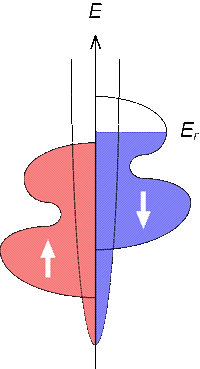ハーフメタル強磁性体とは
Introduction to Half-Metals
 100%のスピン分極率を実現するためには、自発磁化の大きさを制御可能なハーフメタル強磁性体が極めて重要です. ハーフメタル強磁性体はフェルミ面EF近傍でマイノリティースピンにのみバンドギャップが存在し、マジョリティースピンのみが伝導に寄与するために100%のスピン分極率を示します. 現在までに4種類のハーフメタル強磁性体が理論的に予測されています: 酸化物(ルチルCrO2・スピネルFe3O4など)、ペロブスカイト((La,Sr)MnO3など)、閃亜鉛鉱(CrAsなど)、ホイスラー合金(NiMnSbなど). 実験的には、CrO2とLa0.7Sr0.3MnO3がほぼ100%スピン分極していることが低温で報告されていますが、室温で薄膜状態での報告はまだありません. これは応用上必須の特性です.
In order to exploit 100% spin polarisation induced by spontaneous magnetisation, which is different from magnetic semiconductors (e.g., EuO and (Ga,Mn)As) based on the magnetic-filed-induced ferromagnetism due to the Zeeman splitting at low temperature, half-metallic ferromagnets have been intensively investigated recently. The half-metal possesses a bandgap at the Fermi level EF only for its minority spins, achieving 100% spin polarisation at EF [see the spin density of states (DOS) in the figure]. Four types of the half-metallic ferromagnets have theoretically been predicted so far; oxide compounds (e.g., rutile CrO2 and spinel Fe3O4), perovskites (e.g., (La,Sr)MnO3), Zinc-blende compounds (e.g., CrAs) and Heusler alloys (e.g., NiMnSb). Even though both CrO2 and La0.7Sr0.3MnO3 have been reported to show almost perfect spin polarisation at low temperature, to date there has been no experimental report on the half-metallicity at room temperature (RT), which is highly required from the viewpoint of device applications.
100%のスピン分極率を実現するためには、自発磁化の大きさを制御可能なハーフメタル強磁性体が極めて重要です. ハーフメタル強磁性体はフェルミ面EF近傍でマイノリティースピンにのみバンドギャップが存在し、マジョリティースピンのみが伝導に寄与するために100%のスピン分極率を示します. 現在までに4種類のハーフメタル強磁性体が理論的に予測されています: 酸化物(ルチルCrO2・スピネルFe3O4など)、ペロブスカイト((La,Sr)MnO3など)、閃亜鉛鉱(CrAsなど)、ホイスラー合金(NiMnSbなど). 実験的には、CrO2とLa0.7Sr0.3MnO3がほぼ100%スピン分極していることが低温で報告されていますが、室温で薄膜状態での報告はまだありません. これは応用上必須の特性です.
In order to exploit 100% spin polarisation induced by spontaneous magnetisation, which is different from magnetic semiconductors (e.g., EuO and (Ga,Mn)As) based on the magnetic-filed-induced ferromagnetism due to the Zeeman splitting at low temperature, half-metallic ferromagnets have been intensively investigated recently. The half-metal possesses a bandgap at the Fermi level EF only for its minority spins, achieving 100% spin polarisation at EF [see the spin density of states (DOS) in the figure]. Four types of the half-metallic ferromagnets have theoretically been predicted so far; oxide compounds (e.g., rutile CrO2 and spinel Fe3O4), perovskites (e.g., (La,Sr)MnO3), Zinc-blende compounds (e.g., CrAs) and Heusler alloys (e.g., NiMnSb). Even though both CrO2 and La0.7Sr0.3MnO3 have been reported to show almost perfect spin polarisation at low temperature, to date there has been no experimental report on the half-metallicity at room temperature (RT), which is highly required from the viewpoint of device applications.
さらに興味のある方はFor further reading








